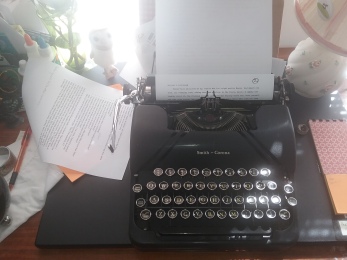by Britton Gildersleeve
Poets—let’s face it—are a bit different. Not just from “normal” folks, but from other readers and writers as well. We know this—even we poet types who also work in other artistic media. Whatever it is that beckons us to poetry, it’s most certainly NOT a call most others hear or heed.
The poet Mark Doty (two-time poetry judge of the Nimrod Awards) once told an audience that people responded with worse recoil he said when he was a poet than when they found out his partner was dying of AIDS. It feels like there’s a kind of fear of poets—and poetry—on the part of most people. And even more in today’s anti-intellectual culture.
When I travel, I sometimes read real, hard-copy books. And they’re often poetry. So it’s not like I could hide them, even if I wanted to. Once someone asked me if a poetry anthology was for a class, and when I said yes, they asked what I was taking. I’m not, I replied; I’m teaching a class in writing poetry. They didn’t ask for another seat—quite—but they did move to the outer edges of comfort in the one next to me.
Still, you expect to be safe with other writers. And, within broad limits, we poets are. We even join the ranks of prose writers: many poets also write prose—creative non-fiction, short stories, novels. Mark Doty, for instance. May Sarton, Nikki Giovanni. Even Shakespeare, if you count historical plays. Raymond Carver’s short stories, Emerson’s huge œuvre, Thomas Hardy’s incredible novels. Alice Walker and Maya Angelou. The list of crossover poets is lengthy and illustrious.
To be a poet is a condition, not a profession. — Robert Graves
So why say poets are different? If poets cross over, don’t prose writers, too? Wellll… the experiences of poets in the writing world leads me to think that once a prose writer (first off, at least), almost always a prose writer, with a few notable exceptions. A dear friend is getting an M.F.A. My friend is a poet, quite a good one. The leader of one of the prose workshops—a published writer—asked my friend, “Why don’t poets use more words?” Really?? Wouldn’t that be . . . prose?
Another example: if you say that you write or teach memoir, or the essay in general (all are true for me), folks are interested. They volunteer their life stories as possible topics, ask for advice. Volunteer that you write poetry? You can hear pins drop on carpet. Oh, I couldn’t do that, comes the eventual comment. My English teacher said my poetry was awful is another (I HATE that teacher!).
Yet another piece of anecdotal support: a good friend recently started a writers’ group. She asked two poets and another fiction writer to the first meeting. Both poets brought poems; she brought a short story. The other fiction writer had no draft. One of the poets handed around a well-done satire on current religico-politics, using the metaphor of the chicken crossing the road as a framing device. The fiction writers didn’t get it, although the poet who wrote the chicken poem was worried it was ham-handed. (It wasn’t.) Both fiction writers felt that the poem needed to be more concrete, more spelled out. (The poets didn’t.)
N.B.: My friend’s short story was excellent, but the other fiction writer felt that IT needed to be more oblique, that the ending was too obvious (the poets didn’t agree). In other words, the two poets and the two fiction writers read the three offerings verrry differently. Why? What is the difference, ultimately, between reading as a poet and reading as a non-poet?
I wonder if the above quotation from Auden doesn’t (as usual) offer one of his utterly simple answers. . . . Fiction writers, even more than creative non-fiction writers, are creatures of narrative webs. While language, image, and other poetic devices may be important in revision, they rarely (almost never?) drive a prose piece. With poets, however, language IS the driver of most pieces. Whether it’s an image the poet is trying to capture in words, or the music of a feeling or experience, language is the raison d’être of poetry.
Not only is it a love affair with language, but poetry is almost a calling. A condition, as Robert Graves said. It’s why William Zinsser—that master of prose craft—found it impossible to think of himself as a poet. Through much of his “apprenticeship” as a poet, as a Diana Goetsch article shows, he sought to reconcile the difference between prose and poetry, even insisting that a poem had to be ‘true’ like non-fiction. Instead of “true,” as Tim O’Brien says of good fiction: Fiction is the lie that helps us understand the truth.
Poets live for word play, for the nuance of an almost archaic etymology, for the slant rhyme or assonance of a line. And, of course, for the “inner life” that Zinsser bemoans his lack of. Also for the “truth,” whatever that is. Prose writers of the very best sort use similar figurative devices, but they don’t drive plot, nor narrative. The “truth” is better served, in fiction, by other elements: characterization, plot (or lack thereof), setting, the narrative arc.

But then again, what if the answer to why poets differ from other writers is an endemic fear of Robert Graves’s poetic “condition”? That would mean . . .I have such a condition! No wonder folks find poetry unsettling! Seriously, though? It’s not like poetic language is deadly, and certainly not more so than stories. In fact, the two often marry beautifully: narrative poetry, prose poems. But for some reason, the poets seem to be held in a great deal more fear than novelists and other prose writers. And I continue to wonder: why is that? What is there to fear? Any ideas?



